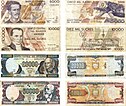Ecuadorian sucre
| Ecuadorian sucre | |||||
|---|---|---|---|---|---|
|
|||||
| ISO 4217 | |||||
| Code | ECS | ||||
| Number | 218 | ||||
| Exponent | 0 | ||||
| Denominations | |||||
| Subunit | |||||
| 1/100 | centavo | ||||
| Plural | sucres | ||||
| centavo | centavos | ||||
| Symbol | S/. | ||||
| Banknotes | 5000, 10,000, 20,000, 50,000 sucres | ||||
| Coins | 100, 500, 1000 sucres | ||||
| Demographics | |||||
| User(s) |
|
||||
| Issuance | |||||
| Central bank | Banco Central del Ecuador | ||||
| Website | www |
||||
|
This infobox shows the latest status before this currency was rendered obsolete.
|
|||||
The sucre was the currency of Ecuador between 1884 and 2000. Its ISO code was ECS and it was subdivided into 10 decimos or 100 centavos. The sucre was named after Antonio José de Sucre.
The Ecuadorian peso was renamed sucre on March 22, 1884, and firmly placed on the silver standard. The sucre was defined as 22.5 g fine silver (equivalent to 5 francs of the Latin Monetary Union.) Substandard coins were withdrawn from 1887 to 1892, with only high-quality silver remaining in circulation.
The fall in the international price of silver accelerated in the 1890s. On November 3, 1898, Ecuador switched to the gold standard, with the sucre defined as 732.224 mg fine gold (equivalent to 2 shillings sterling).
Like so many other currencies, the sucre became inconvertible shortly after World War I began in 1914. The exchange rate kept falling, despite extensive measures to support it. It was finally stabilized during 1926, and on March 4, 1927 Ecuador went on the gold exchange standard, with the sucre equal to 300.933 mg fine gold or US$0.20 (a devaluation of 58.8%).
The gold exchange standard was suspended February 8, 1932. Exchange controls were adopted April 30 and the official rate was fixed at 5.95 (buying) per U.S. dollar. After the price of silver rose above the nominal value of most silver coins in the 1930s, Ecuador embargoed the export of silver (May 17, 1935). This was followed by numerous adjustments to the foreign exchange system as the sucre continued to depreciate. Foreign exchange controls were finally lifted in September 1937 and the official rate was set at 13.5 sucre per U.S. dollar. The sucre was devalued to 14.77 sucre per dollar on June 4, 1940 and exchange controls were reimposed. The official rate became 14 in 1942 and 13.5 in 1944.
Parity was registered with the International Monetary Fund on December 18, 1946 at 65.827 mg fine gold (13.5 per US$), but a system of multiple exchange rates was adopted in 1947. The sucre's IMF par was devalued to 15 sucre per dollar in 1950, to 18 in 1961, and to 25 in 1970.
...
Wikipedia


